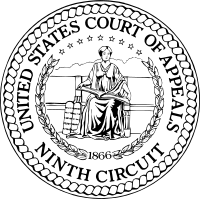See v. Durang
| See v. Durang | |
|---|---|
 | |
| Court | United States Court of Appeals for the Ninth Circuit |
| Full case name | John William SEE, Plaintiff-Appellant, v. Christopher DURANG and L.A. Stage Company, Defendants-Appellees |
| Decided | 22 July 1983 |
| Citation(s) | 711 F.2d 141 |
| Case opinions | |
| Copying deleted or so disguised as to be unrecognizable is not copying. | |
| Court membership | |
| Judge(s) sitting | BROWNING, CHOY and FERGUSON |
| Keywords | |
| copyright infringement | |
See v. Durang (1983) was a case where the author of a play claimed that another playwright had based a second play on a draft script that the plaintiff had written, infringing on its copyright. The court refused to consider the process by which the second play had been created, but chose to simply compare the end results. The court found no infringement, coining the axiom, "Copying deleted or so disguised as to be unrecognizable is not copying."[1]
Background
John William See wrote the play Fear of Acting. Christopher Durang wrote another play, The Actor's Nightmare. There is some similarity in the underlying idea of an inexperienced actor being thrust into a leading role - or in See's play into three different roles. Durang was alleged to have had access to a draft version of See's play. See complained of an infringement of his copyright in Fear of Acting to a district court.[2]
District court findings
The district court summarily dismissed the case on the basis that no reasonable person could find any substantial similarity between the two plays, apart from similarities that naturally followed from the situation and could therefore be ignored under the "scènes à faire" doctrine. The court found the two plays could not be found substantially similar in their expression of ideas. The district court refused to view the finished Fear of Acting, since it had not been alleged that the defendant copied from that version. See appealed this judgement.[2]
Appeals court decision
The United States Court of Appeals for the Ninth Circuit affirmed the district court judgement. The court denied that Sid & Marty Krofft Television Productions Inc. v. McDonald's Corp. said there should be no summary judgement if there is substantial similarity of ideas, and denied that summary judgement could only be granted if the similarities are "trifling". The court said summary judgement was appropriate if reasonable people would not disagree over whether or not there was substantial similarity of expression.[2]
The appeals court examined the alleged similarities, dismissing several on the basis of "scènes à faire" and others on the grounds that they were not similar. Five remained, which the court did not consider to be enough to show substantial similarity. The court found significant differences in the treatment and mood of the two plays. The first describes the various fears of an understudy thrown into playing unfamiliar roles. The second has a dreamlike quality in which an accountant finds himself thrust into acting in a situation that seems normal to everyone but himself. The court defended the district court's decision to compare the plays "as a whole" in looking for substantial similarity, citing Sid & Marty Krofft and Roth Greeting Cards v. United Card Co.[2]
Results
The axiom "Copying deleted or so disguised as to be unrecognizable is not copying" has been quoted in various textbooks and works on copyright law.[3][4][5] It has been quoted in other trials, such as Micro Consulting Inc. v. Zubeldia (1990)[6] and Barbara Chase-Riboud v. DreamWorks, Inc. (1997).[7]
References
- Citations
- ↑ Black 2002, p. 257.
- 1 2 3 4 Browning 1983.
- ↑ Scott 2007, p. 2.270.
- ↑ Stim 2010, p. 46.
- ↑ Fishman 2007, p. 282.
- ↑ West 1990.
- ↑ Collins 1997.
- Sources
- Black, Sharon K. (2002). Telecommunications Law in the Internet Age. Morgan Kaufmann. ISBN 978-1-55860-546-6. Retrieved 2012-06-26.
- Browning (July 22, 1983). "John William SEE, Plaintiff-Appellant, v. Christopher DURANG and L.A. Stage Company, Defendants-Appellees.". United States Court of Appeals, Ninth Circuit. Retrieved 2012-06-26.
- Collins, Audrey B. (1997). "BARBARA CHASE-RIBOUD, Plaintiff, vs. DREAMWORKS, INC., et al., Defendants.". UNITED STATES DISTRICT COURT CENTRAL DISTRICT OF CALIFORNIA. Retrieved 2012-06-26.
- Fishman, Stephen (2007-11-01). Legal Guide to Web & Software Development. Nolo. ISBN 978-1-4133-0532-6. Retrieved 2012-06-26.
- Scott, Michael D. (2007). SCOTT ON INFORMATION TECHNOLOGY LAW, THIRD EDITION. Aspen Publishers Online. ISBN 978-0-7355-6524-1. Retrieved 2012-06-26.
- Stim, Richard (2010-11-03). Getting Permission: How to License & Clear Copyrighted Materials Online & Off. Nolo. ISBN 978-1-4133-1270-6. Retrieved 2012-06-26.
- West, Lee R. (September 19, 1990). "MICRO CONSULTING, INC. v. ZUBELDIA". United States District Court, W.D. Oklahoma. Retrieved 2012-06-26.